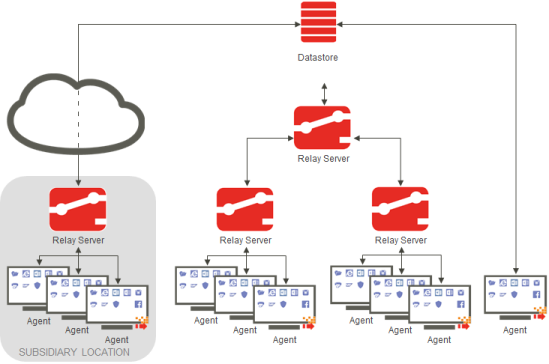Workspace Control Relay Servers
The Relay Server component makes it possible to create a flexible architecture that consolidates and centralizes all Workspace Control configuration data into one central database, while ensuring that dispersed Agents across multiple sites obtain configuration data efficiently and in a timely manner.
Relay Servers are an optional infrastructure component. Relay Servers cache information from the Datastore and pass it on to Agents or to other Relay Servers. Agents can be configured to contact the Datastore directly, or to use Relay Servers.
In a Workspace Control site, both methods can be used at the same time, with some Agents connecting to the Datastore and others using Relay Servers.

Relay Servers offer several advantages:
- Improved scalability in all kinds of distributed network topologies.
- Reduced network traffic in multiple-site environments, as fewer components connect directly to the central Datastore over relatively slow data connections.
- Reduced Datastore load, as fewer components connect directly to the central Datastore.
- Agents that connect to Relay Servers do not need to have a database driver installed for the Workspace Control Datastore.
Cascaded Relay Servers
In an environment with cascaded Relay Servers where more than 50,000 transactions exist in the queue of one of the Relay Servers or there is less than 500 MB free disk space on the Relay Server, the Relay Server will stop to accept new transactions from Agents or other Relay Servers. They are then redirected to another Relay Server. When the queue has been reduced to 40,000 queued transactions or free disk space increased by 10% to 550 MB, the Relay Server will accept new transactions again.
For further details about Relay Servers, see the document Getting Started with Workspace Control Relay Servers.